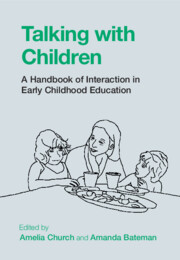Book contents
- Talking with Children
- Talking with Children
- Copyright page
- Dedication
- Contents
- Figures
- Tables
- Contributors
- Acknowledgements
- Notes on Transcription Conventions
- Introduction
- Part I Talk as Social Action
- Part II Pedagogy in Interaction
- Part III Interaction and Inclusion
- 15 Play
- 16 Mental Health and Wellbeing
- 17 Neurodiversity
- 18 Friendships
- 19 Conflict
- 20 Morality
- 21 Families
- Index
- References
15 - Play
from Part III - Interaction and Inclusion
Published online by Cambridge University Press: 16 June 2022
- Talking with Children
- Talking with Children
- Copyright page
- Dedication
- Contents
- Figures
- Tables
- Contributors
- Acknowledgements
- Notes on Transcription Conventions
- Introduction
- Part I Talk as Social Action
- Part II Pedagogy in Interaction
- Part III Interaction and Inclusion
- 15 Play
- 16 Mental Health and Wellbeing
- 17 Neurodiversity
- 18 Friendships
- 19 Conflict
- 20 Morality
- 21 Families
- Index
- References
Summary
Belonging is a concept with positive meaning that relates to togetherness and social fellowship. Belonging can be understood at different levels: most immediately it relates to close relationships and attachment, i.e. belonging to a family or a group of peers. In a wider perspective, belonging deals with being a part of society and its culture and language(s). For a child who enters the preschool, belonging is essential for the child’s wellbeing, development and learning. Hence, many preschool curricula emphasize the importance of belonging. In the Swedish preschool curriculum belonging is foremost related to the child’s development of responsibility and solidarity as a part of its socialization in civics and democracy. The accomplishment of belonging can be challenging, because the conditions for children’s affiliation at preschool differ as they often enter with diverse experiences – linguistically, culturally and socially. A crucial point is the educators’ attitude and view of the child and her/his abilities. This chapter aims to highlight and discuss how belonging can be accomplished in everyday practice at preschool. The data details how teachers and peers contribute to a child’s sense of belonging in various activities or situations; for example, welcoming as a joint accomplishment, embodied greetings, making each child visible and respecting children’s play framework.
- Type
- Chapter
- Information
- Talking with ChildrenA Handbook of Interaction in Early Childhood Education, pp. 309 - 330Publisher: Cambridge University PressPrint publication year: 2022
References
- 2
- Cited by

